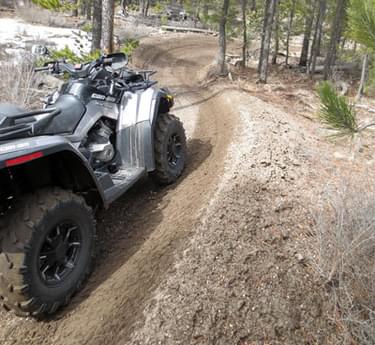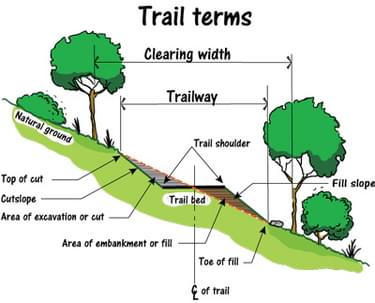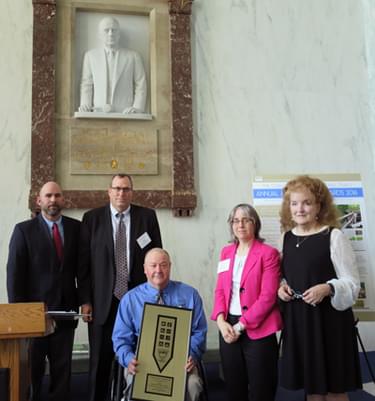
Education and Communication
Great Trails: Providing Quality OHV Trails and Experiences Guidebook (Nationwide)

Cover of the guidebook
Development of a major resource for planning, designing, constructing, maintaining, and managing OHV recreational trails and trail systems.
Great Trails: Providing Quality OHV Trails and Experiences is the definitive resource for planning, designing, constructing, maintaining, and managing Off-Highway Vehicle (OHV) recreational trails and trail systems. The primary audience for the guidebook is state and federal planners, trail managers, and land managers. Others who will find the publication invaluable include trail volunteers, OHV clubs and associations, and private land owners and trail managers.
In 2011 research by the National Off-Highway Vehicle Conservation Council (NOHVCC) concluded that the existing publications regarding OHV trail design, construction, and maintenance were outdated, did not include information about newer vehicle types, and didn’t include information about the latest design, construction, and maintenance techniques. Most of the material was created on the 1970s prior to the introduction of All-Terrain Vehicles (ATV). Several were updated in the 1990s prior to Recreational Off-Highway Vehicles (ROV or side by side).
We also discovered trail planners and managers were in desperate need of a source of information for specifying trail designs on public lands. Some managers were turning to the IMBA trail publications for trail specification on OHV trails. While the IMBA books are fantastic resources for planning and designing bicycle trails, the designs don’t account for the differences in vehicle size, weight, or the dynamics of motorized propulsion.
The theme of the book is “balancing the needs of the recreationists with protection of resources.” The book also helps land managers understand that trail planning, design, construction, maintenance, and management are not five separate processes but rather one continuous process referred to in the book as “the Great Trail Continuum.” Applying the “Great Trail Continuum” will result in trails that meet the user’s needs, are fun to ride, and are sustainable. The guide stresses the importance of providing trails for riders that are fun and challenging. The trail becomes the management tool because riders have trails “they want to ride,” not “trails they have to ride.”
The author of the book is Dick Dufourd, one of the nations most recognized experts on OHV trail design, construction, maintenance and management. Dick is a retired USFS and BLM land manager with over 30 years’ experience in the field of OHV recreation. Dick also consulted with 22 individuals who contributed content for the book. Many are acknowledged experts in specific subject areas.
The narrative writing style allows the reader to easily grasp the concepts and techniques described in the book. The content is arranged in chapters that each include case studies and segments like “A Closer Look,” “Tips, Tricks, or Traps,” and Chapter summaries. The book is also graphic-rich with approximately 1,000 photos and 50 illustrations to convey information to the reader.
Off-Highway Vehicle Recreation is enjoyed by many people with disabilities as well as people of all ages. The guidebook provides the reader with information about facility design to accommodate people with disabilities.
The content of the book is focused on OHV recreation. However, many of the concepts in the book can be applied to any type of trail system where the desired outcome is a well-designed, sustainable trail which meets the needs of the trail users.
As part of the over-all package for the guidebook content, NOHVCC has created a new website, www.greatohvtrails.com, to make the content of the guidebook available on line as well as provide additional information, including instructional videos, to support the book. The website includes an on- line order form for the printed book or a link to download the book by the chapter in high-resolution for print or in its entirety as a low resolution document for use on computers or tablets. The website is separated into four sections that correspond with the four sections of the printed guidebook.
Other highlights about the website include:
- Content is easy to find.
- Information is broken into small, understandable sections
- The left-hand navigation panel is dynamic
- Download speeds are very fast
- Photos can be enlarged for better viewing
- Responsive design. The website is built using a responsive framework allowing the size of the content to scale for better viewing on different size devices. This means that the website will self-adjust to fit on any device, such as a computer, tablet or phone.
The need for the guidebook was initially demonstrated by the number and types of partners and contributors to the book. These partners include OHV businesses and industry, OHV clubs and associations, national OHV organizations, State governments, and federal agencies. Funding for the book was provided by:
- Amateur Riders Motorcycle Association
- American Motorcyclist Association
- Bureau of Land Management
- Canadian Off-Highway Vehicle Distributors Council
- Federal Highway Administration
- Golden Eagles Motorcycle Club
- Idaho State Parks and Recreation
- International Off-Highway Vehicle Administrators Association
- Kawasaki Motors Corporation
- Maine Department of Conservation
- Maryland State Highway Administration
- Massachusetts Department of Conservation and Recreation
- Michigan Department of Natural Resources
- Minnesota Department of Natural Resources
- Montana State Parks
- Montana Trail Vehicle Riders Association
- Motorcycle Industry Council
- New Mexico Game and Fish
- Ohio Motorized Trail Association
- Oregon Motorcycle Riders Association
- Polaris Foundation
- Recreational Off-Highway Vehicle Association
- Right Rider Access Fund
- Specialty Vehicle Institute of America
- Texas Parks and Wildlife
- United Four Wheel Drive Association
- USDA Forest Service
- Utah State Parks
- Yamaha Outdoor Access Initiative
This project started in 2012 as part of a contract with FHWA. The guidebook was printed as a final draft in October 2015 and distributed to attendees of the annual NOHVCC conference. Feedback was collected from the audience to refine the document. The first volume printing was completed in January 2015.
The guidebook has been in high demand since it was introduced. The website dedicated to the guidebook content contains all of the text, plus additional text and references. Photos and illustrations have been loaded to the website through chapter 5 to date. Website work continues with the full book content targeted to be online this summer.
Currently copies of the entire guidebook can be downloaded as pdf files from the guidebook website or hard copies can be purchased from NOHVCC or American Trails. A pocket field guide is being developed as an accompanying tool.
More winners of this award
2023: Avalanche Beacon Checking Station Signs
2023: Sensible, Courteous, Off-Road, Enthusiasts / SCORE
2021: Sign Language Saturday
2020: Nevada’s Outdoor School’s Outdoor Ethics Program
2019: Gallatin National Forest Avalanche Center (GNFAC) – Montana
2018: Spearhead Trails - Virginia
2017: Woodruff Greenway Trail - South Carolina
2015: Blue Tree Trail System - Nevada
2014: Missouri State Parks Trail Book
2013: School Messaging Program - Minnesota
2012: Intertwine Alliance Bi-State Regional Trails Website - Oregon and Washingston
2011: Shadow Mountain Trail System - Wyoming
2010: Coalition of Recreational Trail Users Educational Trailer - Minnesota
2009: Giant's Stairs Trail Project - Maine
2008: Recreation Maps and Educational Materials - Wyoming
2007: Trail Planning, Design & Development Guidelines Book - Minnesota
2006: Washington & Old Dominion Railroad Regional Park - Virginia
2005: North Slope Trailer Project - Wyoming
2004: Western Wyoming Avalanche Education - Wyoming
2004: Sensible, Courteous Off Road Enthusiasts (SCORE) - Pennsylvania
2003: Green Ridge State Forest & Rocky Gap State Park Trail - Maryland



